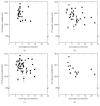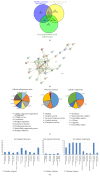Urinary Extracellular Vesicles: Potential Biomarkers of Renal Function in Diabetic Patients
- PMID: 28105442
- PMCID: PMC5220476
- DOI: 10.1155/2016/5741518
Urinary Extracellular Vesicles: Potential Biomarkers of Renal Function in Diabetic Patients
Abstract
The aim of this study was to check the relationship between the density of urinary EVs, their size distribution, and the progress of early renal damage in type 2 diabetic patients (DMt2). Patients were enrolled to this study, and glycated hemoglobin (HbA1c) below 7% was a threshold for properly controlled diabetic patients (CD) and poorly controlled diabetic patients (UD). Patients were further divided into two groups: diabetic patients without renal failure (NRF) and with renal failure (RF) according to the Glomerular Filtration Rate. Density and diameter of EVs were determined by Tunable Resistive Pulse Sensing. Additionally, EVs were visualized by means of Transmission and Environmental Scanning Electron Microscopy. Nano-liquid chromatography coupled offline with mass spectrometry (MALDI-TOF-MS/MS) was applied for proteomic analysis. RF had reduced density of EVs compared to NRF. The size distribution study showed that CD had larger EVs (mode) than UD (115 versus 109 nm; p < 0.05); nevertheless the mean EVs diameter was smaller in controls than in the CD group (123 versus 134 nm; p < 0.05). It was demonstrated that EVs are abundant in urine. Albumin, uromodulin, and number of unique proteins related to cell stress and secretion were detected in the EVs fraction. Density and size of urinary EVs reflect deteriorated renal function and can be considered as potential renal damage biomarkers.
Conflict of interest statement
The authors declare that they have no competing interests.
Figures





References
-
- National Kidney Foundation. Diabetes—a major risk factor for kidney disease, https://www.kidney.org/news/newsroom/factsheets/FastFacts/
MeSH terms
Substances
LinkOut - more resources
Full Text Sources
Other Literature Sources
Medical

